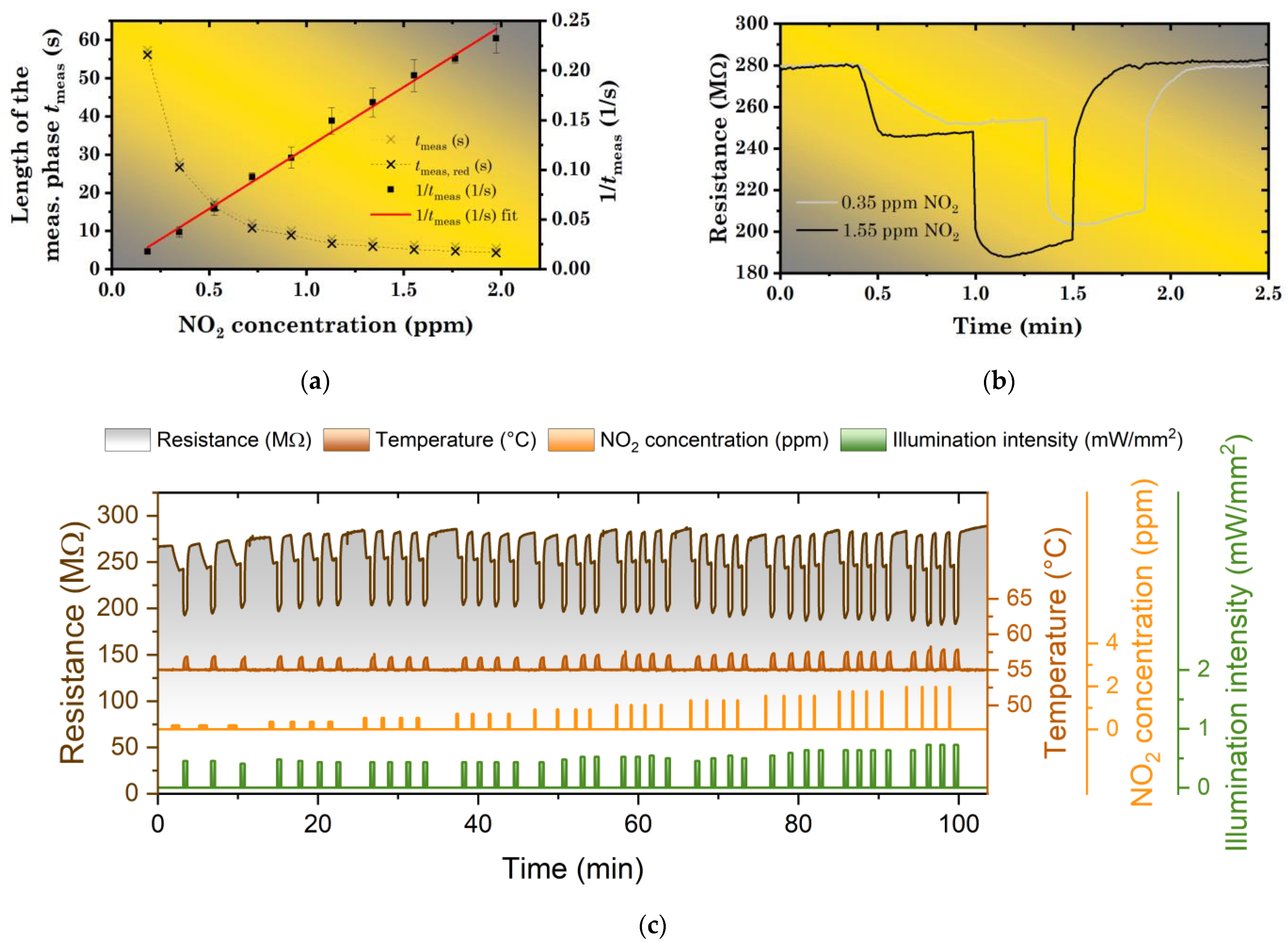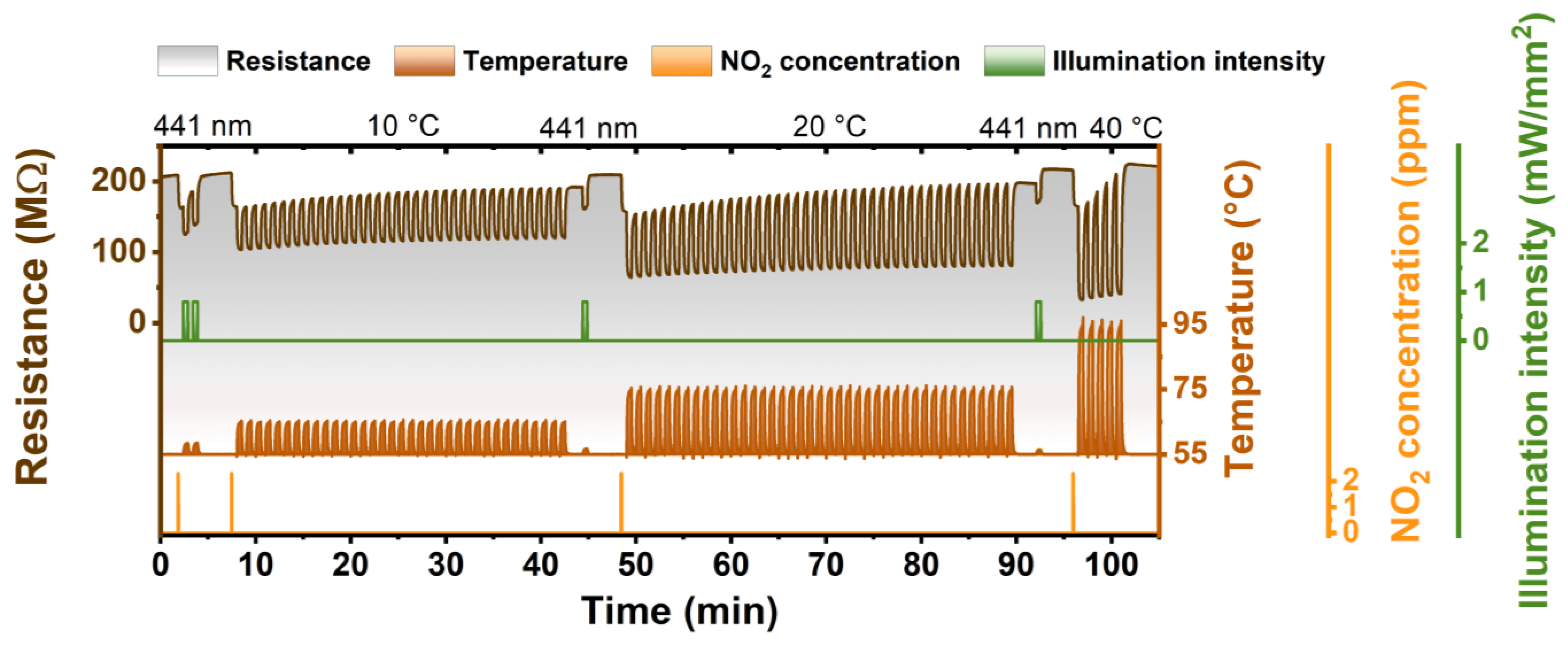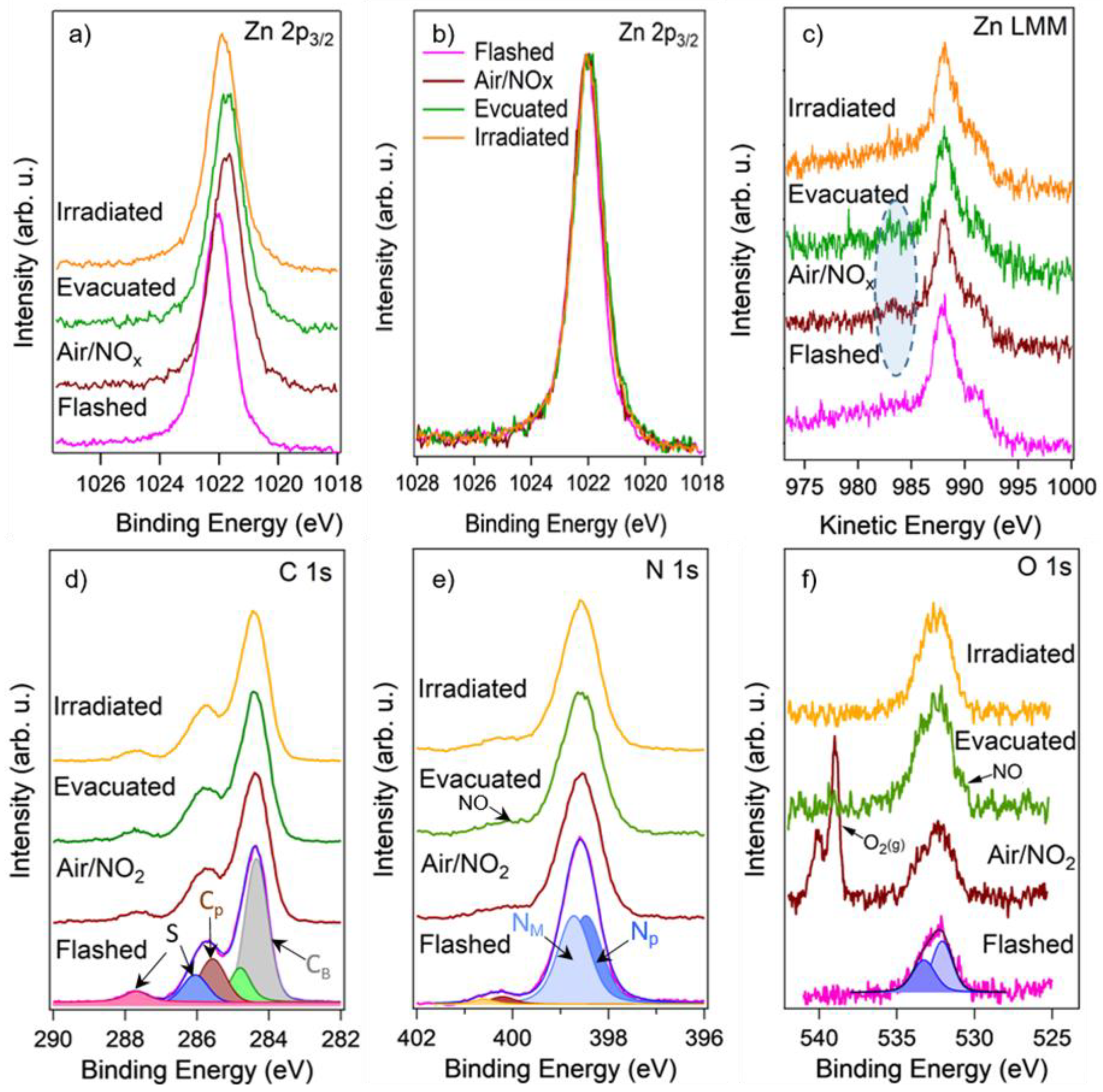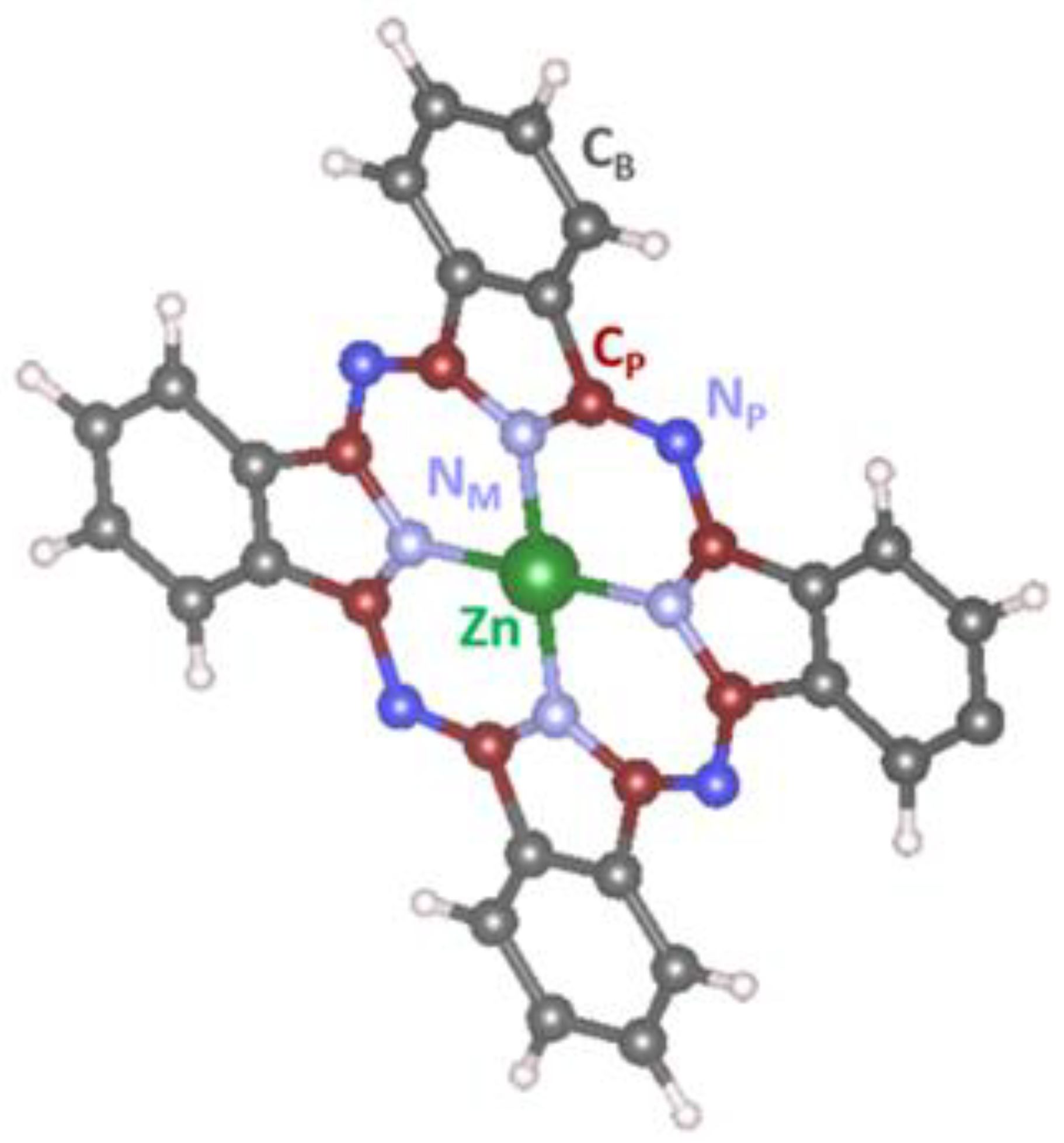Study of Photoregeneration of Zinc Phthalocyanine Chemiresistor after Exposure to Nitrogen Dioxide
Abstract
:1. Introduction
2. Materials and Methods
2.1. Preparation of ZnPc Chemiresistors
2.2. Measurement of Sensor Response to Nitrogen Dioxide
2.3. Photoregeneration of the Sensor by LED
2.4. Measurement of Raman Spectra (SERS)
2.5. NAP-XPS Measurements
3. Results
3.1. ZnPc Photoregeneration as a Function of Wavelength and Sensor Temperature
3.2. Photoregeneration of ZnPc Sensors within the Regime of a Constant Exposure Dose
3.3. Comparison of Photoregeneration and Temperature Regeneration under Dark Conditions
3.4. Raman (SERS) Study of Photoregeneration of ZnPc Layers
3.5. NAP-XPS Study of Photoregeneration of ZnPc Layers in the Presence of NO2
4. Conclusions
Supplementary Materials
Author Contributions
Funding
Institutional Review Board Statement
Informed Consent Statement
Data Availability Statement
Acknowledgments
Conflicts of Interest
References
- Wöhrle, D.; Kreienhoop, L.; Schlettwein, D. Phthalocyanines and related macrocycles in organic phototovoltaic junctions. In Phthalocyanines, Properties, and Applications; VCH Publishers Inc.: New York, NY, USA, 1996. [Google Scholar]
- Cranston, R.R.; Lessard, B.H. Metal phthalocyanines: Thin-film formation, microstructure, and physical properties. RSC Adv. 2021, 11, 21716–21737. [Google Scholar] [CrossRef]
- Gregory, P. Industrial applications of phthalocyanines. J. Porphyr. Phthalocyanines 2000, 4, 432–437. [Google Scholar] [CrossRef]
- Williams, G.; Sutty, S.; Klenkler, R.; Aziz, H. Renewed interest in metal phthalocyanine donors for small molecule organic solar cells. Sol. Energy Mater. Sol. Cells 2014, 124, 217–226. [Google Scholar] [CrossRef]
- Vesselli, E. Tetrapyrroles at near-ambient pressure: Porphyrins and phthalocyanines beyond the pressure gap. J. Phys. Mater. 2020, 3, 022002. [Google Scholar] [CrossRef]
- Rydosz, A.; Maciak, E.; Wincza, K.; Gruszczynski, S. Microwave-based sensors with phthalocyanine films for acetone, ethanol and methanol detection. Sens. Actuators B Chem. 2016, 237, 876–886. [Google Scholar] [CrossRef]
- Rossignol, J.; Barochi, G.; De Fonseca, B.; Brunet, J.; Bouvet, M.; Pauly, A.; Markey, L. Microwave-based gas sensor with phthalocyanine film at room temperature. Sens. Actuators B Chem. 2013, 189, 213–216. [Google Scholar] [CrossRef]
- Brunet, J.; Garcia, V.P.; Pauly, A.; Varenne, C.; Lauron, B. An optimised gas sensor microsystem for accurate and real-time measurement of nitrogen dioxide at ppb level. Sens. Actuators B Chem. 2008, 134, 632–639. [Google Scholar] [CrossRef]
- Wilson, A.; Wright, J.D. Understanding and optimising NO2-sensing using semiconducting phthalocyanine films. Mol. Cryst. Liq. Cryst. Sci. Technol. A Mol. Cryst. Liq. Cryst. 1992, 211, 321–326. [Google Scholar] [CrossRef]
- Zhou, Q.; Gould, R.D. A study of the response rate to nitrogen dioxide exposure in metal phthalocyanine thin film sensors. Thin Solid Films 1998, 317, 436–439. [Google Scholar] [CrossRef]
- Jalil, A.R.; Chang, H.; Bandari, V.K.; Robaschik, P.; Zhang, J.; Siles, P.F.; Li, G.; Bürger, D.; Grimm, D.; Liu, X.; et al. Fully Integrated Organic Nanocrystal Diode as High Performance Room Temperature NO2 Sensor. Adv. Mater. 2016, 28, 2971–2977. [Google Scholar] [CrossRef] [PubMed]
- Newton, M.I.; Starke, T.K.H.; Willis, M.R.; McHale, G. NO2 detection at room temperature with copper phthalocyanine thin film devices. Sens. Actuators B Chem. 2000, 67, 307–311. [Google Scholar] [CrossRef]
- Wilson, A.; Wright, J.D.; Chadwick, A.V. A microprocessor-controlled nitrogen dioxide sensing system. Sensors Actuators B. Chem. 1991, 4, 499–504. [Google Scholar] [CrossRef]
- Wright, J.D. Gas adsorption on phthalocyanines and its effects on electrical properties. Prog. Surf. Sci. 1989, 31, 1–60. [Google Scholar] [CrossRef]
- Masel, R.I. Principles of Adsorption and Reaction on Solid Surfaces; John Wiley & Sons: New York, NY, USA, 1996. [Google Scholar]
- Passard, M.; Maleysson, C.; Pauly, A.; Dogo, S.; Germain, J.P.; Blanc, J.P. Gas sensitivity of phthalocyanine thin films. Sens. Actuators B Chem. 1994, 19, 489–492. [Google Scholar] [CrossRef]
- Guillaud, G.; Simon, J.; Germain, J.P. Metallophthalocyanines gas sensors, resistors and field effect transistors. Coord. Chem. Rev. 1998, 178–180, 1433–1484. [Google Scholar] [CrossRef]
- Li, J.; Liu, M.; Jiang, J.; Liu, B.; Tong, H.; Xu, Z.; Yang, C.; Qian, D. Morphology-controlled electrochemical sensing properties of CuS crystals for tartrazine and sunset yellow. Sens. Actuators B Chem. 2019, 288, 552–563. [Google Scholar] [CrossRef]
- Li, J.; Jiang, J.; Zhao, D.; Xu, Z.; Liu, M.; Liu, X.; Tong, H.; Qian, D. Novel hierarchical sea urchin-like Prussian blue@palladium core–shell heterostructures supported on nitrogen-doped reduced graphene oxide: Facile synthesis and excellent guanine sensing performance. Electrochim. Acta 2020, 330, 135196. [Google Scholar] [CrossRef]
- Padma, N.; Joshi, A.; Singh, A.; Deshpande, S.K.; Aswal, D.K.; Gupta, S.K.; Yakhmi, J.V. NO2 sensors with room temperature operation and long term stability using copper phthalocyanine thin films. Sens. Actuators B Chem. 2009, 143, 246–252. [Google Scholar] [CrossRef]
- Liu, C.J.; Shih, J.J.; Ju, Y.H. Surface morphology and gas sensing characteristics of nickel phthalocyanine thin films. Sens. Actuators B Chem. 2004, 99, 344–349. [Google Scholar] [CrossRef]
- Pizzini, S.; Timo, G.L.; Beghi, M.; Butta, N.; Mari, C.M.; Faltenmaier, J. Influence of the structure and morphology on the sensitivity to nitrogen oxides of phthalocyanine thin-film resistivity sensors. Sens. Actuators 1989, 17, 481–491. [Google Scholar] [CrossRef]
- Sadaoka, Y.; Jones, T.A.; Revell, G.S.; Göpel, W. Effects of morphology on NO2 detection in air at room temperature with phthalocyanine thin films. J. Mater. Sci. 1990, 25, 5257–5268. [Google Scholar] [CrossRef]
- Reddy, S.M. Materials for Chemical Sensing; Paixão, T.R.L.C., Ed.; Springer International Publishing AG: Cham, Switzerland, 2017. [Google Scholar]
- Baldini, F.; Capobianchi, A.; Falai, A.; Mencaglia, A.A.; Pennesi, G. Reversible and selective detection of NO2 by means of optical fibres. Sens. Actuators B Chem. 2001, 74, 12–17. [Google Scholar] [CrossRef]
- Bueno, A.; Lahem, D.; Caucheteur, C.; Debliquy, M. Reversible NO2 optical fiber chemical sensor based on LuPc2 using simultaneous transmission of UV and visible light. Sensors 2015, 15, 9870–9881. [Google Scholar] [CrossRef] [Green Version]
- Chizhov, A.S.; Rumyantseva, M.N.; Vasiliev, R.B.; Filatova, D.G.; Drozdov, K.A.; Krylov, I.V.; Abakumov, A.M.; Gaskov, A.M. Visible light activated room temperature gas sensors based on nanocrystalline ZnO sensitized with CdSe quantum dots. Sens. Actuators B Chem. 2014, 205, 305–312. [Google Scholar] [CrossRef]
- Vorokhta, M.; Khalakhan, I.; Vondráček, M.; Tomeček, D.; Vorokhta, M.; Marešová, E.; Nováková, J.; Vlček, J.; Fitl, P.; Novotný, M.; et al. Investigation of gas sensing mechanism of SnO2 based chemiresistor using near ambient pressure XPS. Surf. Sci. 2018, 687, 284–290. [Google Scholar] [CrossRef]
- Hozák, P.; Vorokhta, M.; Khalakhan, I.; Jarkovská, K.; Cibulková, J.; Fitl, P.; Vlček, J.; Fara, J.; Tomeček, D.; Novotný, M.; et al. New Insight into the Gas-Sensing Properties of CuOx Nanowires by Near-Ambient Pressure XPS. J. Phys. Chem. C 2019, 123, 29739–29749. [Google Scholar] [CrossRef]
- Piliai, L.; Tomeček, D.; Hruška, M.; Khalakhan, I.; Nováková, J.; Fitl, P.; Yatskiv, R.; Grym, J.; Vorokhta, M.; Matolínová, I.; et al. New insights towards high-temperature ethanol-sensing mechanism of ZnO-Based chemiresistors. Sensors 2020, 20, 5602. [Google Scholar] [CrossRef]
- Tomecek, D.; Hruska, M.; Fitl, P.; Vlcek, J.; Maresova, E.; Havlova, S.; Patrone, L.; Vrnata, M. Phthalocyanine Photoregeneration for Low Power Consumption Chemiresistors. ACS Sens. 2018, 3, 2558–2565. [Google Scholar] [CrossRef]
- Park, J.H.; Natesan, K. Oxidation of copper and electronic transport in copper oxides. Oxid. Met. 1993, 39, 411–435. [Google Scholar] [CrossRef]
- SenGupta, S.; Upadhyaya, H.P.; Kumar, A.; Dhanya, S.; Naik, P.D.; Bajaj, P. Photodissociation dynamics of nitrotoluene at 193 and 248 nm: Direct observation of OH formation. Chem. Phys. Lett. 2008, 452, 239–244. [Google Scholar] [CrossRef]
- Haidry, A.A.; Kind, N.; Saruhan, B. Investigating the influence of Al-doping and background humidity on NO2 sensing characteristics of magnetron-sputtered SnO2 sensors. J. Sens. Sens. Syst. 2015, 4, 271–280. [Google Scholar] [CrossRef] [Green Version]
- Gomez-Alvarez, M.A.; Morales, C.; Méndez, J.; del Campo, A.; Urbanos, F.J.; Díaz, A.; Reséndiz, L.; Flege, J.I.; Granados, D.; Soriano, L. A Comparative Study of the ZnO Growth on Graphene and Graphene Oxide: The Role of the Initial Oxidation State of Carbon. C J. Carbon Res. 2020, 6, 41. [Google Scholar] [CrossRef]
- Deroubaix, G.; Marcus, P. X-ray photoelectron spectroscopy analysis of copper and zinc oxides and sulphides. Surf. Interface Anal. 1992, 18, 39–46. [Google Scholar] [CrossRef]
- Dake, L.S.; Baer, D.R.; Zachara, J.M. Auger parameter measurements of zinc compounds relevant to zinc transport in the environment. Surf. Interface Anal. 1989, 14, 71–75. [Google Scholar] [CrossRef]
- Evangelista, F.; Carravetta, V.; Stefani, G.; Jansik, B.; Alagia, M.; Stranges, S.; Ruocco, A. Electronic structure of copper phthalocyanine: An experimental and theoretical study of occupied and unoccupied levels. J. Chem. Phys. 2007, 126, 124709. [Google Scholar] [CrossRef] [PubMed]
- Nguyen, T.Q.; Escaño, M.C.S.; Kasai, H. Nitric oxide adsorption effects on metal phthalocyanines. J. Phys. Chem. B 2010, 114, 10017–10021. [Google Scholar] [CrossRef]
- De Oteyza, D.G.; El-Sayed, A.; Garcia-Lastra, J.M.; Goiri, E.; Krauss, T.N.; Turak, A.; Barrena, E.; Dosch, H.; Zegenhagen, J.; Rubio, A.; et al. Copper-phthalocyanine based metal-organic interfaces: The effect of fluorination, the substrate, and its symmetry. J. Chem. Phys. 2010, 133, 214703. [Google Scholar] [CrossRef] [Green Version]
- Herranz, T.; Deng, X.; Cabot, A.; Liu, Z.; Salmeron, M. In situ XPS study of the adsorption and reactions of NO and O2 on gold nanoparticles deposited on TiO2 and SiO2. J. Catal. 2011, 283, 119–123. [Google Scholar] [CrossRef]
- Park, J.H.; Royer, J.E.; Chagarov, E.; Kaufman-Osborn, T.; Edmonds, M.; Kent, T.; Lee, S.; Trogler, W.C.; Kummel, A.C. Atomic imaging of the irreversible sensing mechanism of NO2 adsorption on copper phthalocyanine. J. Am. Chem. Soc. 2013, 135, 14600–14609. [Google Scholar] [CrossRef]
- Baltrusaitis, J.; Jayaweera, P.M.; Grassian, V.H. XPS study of nitrogen dioxide adsorption on metal oxide particle surfaces under different environmental conditions. Phys. Chem. Chem. Phys. 2009, 11, 8295–8305. [Google Scholar] [CrossRef]









Publisher’s Note: MDPI stays neutral with regard to jurisdictional claims in published maps and institutional affiliations. |
© 2021 by the authors. Licensee MDPI, Basel, Switzerland. This article is an open access article distributed under the terms and conditions of the Creative Commons Attribution (CC BY) license (https://creativecommons.org/licenses/by/4.0/).
Share and Cite
Tomeček, D.; Piliai, L.; Hruška, M.; Fitl, P.; Gadenne, V.; Vorokhta, M.; Matolínová, I.; Vrňata, M. Study of Photoregeneration of Zinc Phthalocyanine Chemiresistor after Exposure to Nitrogen Dioxide. Chemosensors 2021, 9, 237. https://doi.org/10.3390/chemosensors9090237
Tomeček D, Piliai L, Hruška M, Fitl P, Gadenne V, Vorokhta M, Matolínová I, Vrňata M. Study of Photoregeneration of Zinc Phthalocyanine Chemiresistor after Exposure to Nitrogen Dioxide. Chemosensors. 2021; 9(9):237. https://doi.org/10.3390/chemosensors9090237
Chicago/Turabian StyleTomeček, David, Lesia Piliai, Martin Hruška, Přemysl Fitl, Virginie Gadenne, Mykhailo Vorokhta, Iva Matolínová, and Martin Vrňata. 2021. "Study of Photoregeneration of Zinc Phthalocyanine Chemiresistor after Exposure to Nitrogen Dioxide" Chemosensors 9, no. 9: 237. https://doi.org/10.3390/chemosensors9090237
APA StyleTomeček, D., Piliai, L., Hruška, M., Fitl, P., Gadenne, V., Vorokhta, M., Matolínová, I., & Vrňata, M. (2021). Study of Photoregeneration of Zinc Phthalocyanine Chemiresistor after Exposure to Nitrogen Dioxide. Chemosensors, 9(9), 237. https://doi.org/10.3390/chemosensors9090237







